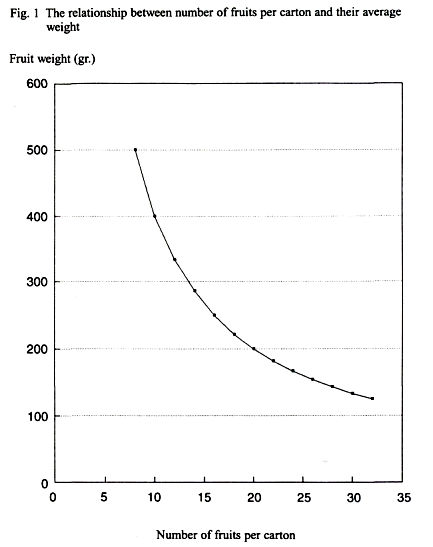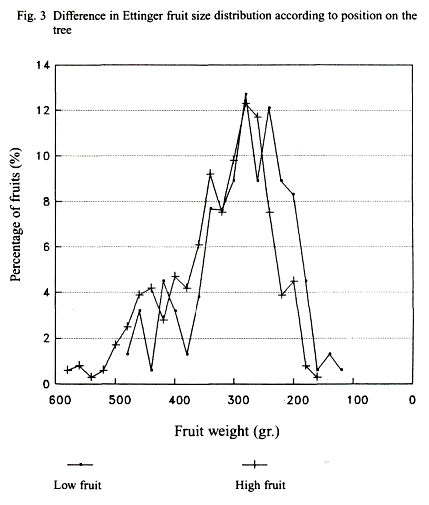ON AVOCADO FRUIT SIZE II. FRUIT SIZE GRADING
D. N. Zamet
ACCO Experimental Station, Ministry of Agriculture,
SUMMARY
Fruit size grading is an important tool for
evaluating differences between experimental treatments; however, most grading
for this purpose is carried out in commercial packing stations and according to
commercial requirements. Part II of this series of articles on avocado fruit
size shows the difference between commercial grading and what can be called
"accurate grading". It also explains the reason for the use of
accurate grading in this series of articles. The proposition is put forward
that accurate grading, as opposed to commercial grading is a far more important
and sensitive tool for examining experimental results.
INTRODUCTION
Grading by fruit size is one of the most important
parameters for the research worker who wishes to know what effect, if any, a
certain treatment (or treatments) has had on the fruit trees he has been
working with. This grading is usually carried out in commercial packing
stations, or at least according to commercial requirements. In
METHODS
First, a distribution curve for average fruit weight
for commercial grading was drawn. Secondly, 510 fruits of the Ettinger cultivar, the total crop of a few six year old
trees, were picked, marked according to their height above soil level, and each
one weighed on a spring balance to the nearest gram. Maximum height of the
trees was about four meters. Fruit weight distribution curves were drawn
according to two methods. In the first place, the fruit weights were sorted
into groups according to the commercial method and again into 20 gram groups.
In the second place, they were divided into those picked below one meter above
soil level or those picked above one meter. In each of the four cases, the
percentage of fruit in each grouping was calculated.
RESULTS AND
DISCUSSION
The results of the various gradings
are shown in Figures 1, 2, and 3. In Figure 1 we can see clearly that as the
number of fruit per carton goes down the average weight per fruit increases and
at an increasing rate. Thus, between 32 and 30 fruits per carton there is an
average weight difference of only 8 grams, whereas between 10 and 8 fruits per
carton this has risen to 100 grams! True, even using this method of grading it
is possible to find differences between treatments. However, it is a very
unequal method of grading and cannot show up the fine differences which can be
seen in the accurate method.

When we examine Figure 2 we can see
the two very different pictures obtained by the grading the same 510 fruits. The commercial method gives a mono-modial distribution curve (which is what we would expect
with regard to the work of Zilka and Klein (5) and
the fact that flowering in the avocado is basically also mono-modial). With the distribution curve of the accurate, or 20
gram, method we have an irregular or multi-modial
curve. Papers which have been published in the last two decades (1, 2, 3, 5) enable us to understand why this multi-modial curve is obtained. It can be understood from these
works that in the 20 gram distribution curve we have a historical record of
climatic conditions and soil conditions prevailing, months prior to picking,
during the flowering period. It must be pointed out again that these two so
different distribution curves are based on the same 510 fruits and on the same weighings. Before we try to learn something from this 20
gram distribution curve, we must bear in mind that Zilka
and Klein (5) have shown that large Hass fruit set before small Hass fruit, and
it seems reasonable to assume that this is true for all cultivars. The first
thing that this distribution curve suggests is that about 2/3 numerically of
the fruit set in the second half of the flowering period. Next, as the peakings are not very sharp, it is suggested that the Ettinger cultivar is not highly sensitive to low minimum
temperature during flowering; it is an accepted fact that Ettinger
is a high yielding cultivar. No big, sudden changes can be seen in the
distribution curve which could be expected if, for example, citrus was acting
as a competitor for the services of the honey bee. Fruit set occurred early in
the flowering period, with some small peaks as the minimum air temperature was
high but still on a very low scale. The fruit set improves very slowly so that
it reaches a maximum only after two—thirds of the flowering period. The fact
that fruit set occurred early in the flowering period, but at a very low rate,
indicates that this was not due to lack of bees or to too low minimum air
temperature but (on the basis of the work of Lahav and Trocioulis
(1)) on the lack of sufficient root activity due to low soil temperature (this
will be dealt with in a further part of this series) or to insufficient roots
left alive after too wet winter conditions (2). Both of these could result in
insufficient moisture and/or nutrient uptake to suffice the needs of the
flowers and very young fruitlets and thus be the
cause of the low initial fruit set. The orchard in question is known to suffer
from drainage problems and the yield in the year the fruit was picked was only
about half the expected level.


In Figure 3 we again have the same 510 fruits, but
divided into low and high fruit according to their position on the trees. Here
we can see that the high fruit began setting before the lower fruit. Flowering
usually commences a little earlier in the higher parts of the tree. This could
be due to better light conditions, to slightly warmer minimum air temperatures
(unpublished work of Lomas and Zamet),
or to temperature inversion on clear nights. The fact that peaking in the lower
fruit is far stronger than in the upper fruit also indicates that minimum air
temperature in the upper part of the trees was more conducive to fruit set. It
would seem reasonable to accept that any method which will improve soil
conditions prior to and during flowering, and any method which will raise
minimum air temperature, especially during the early part of flowering, will
lead to higher yields and larger fruit.
In conclusion, it is suggested that accurate fruit
size grading, such as the 20 gram method used here (or even the 2 gram method
used for parthenocarpic fruit (4) is an extremely
valuable diagnostic tool which can be used for the understanding of many
problems connected with avocado productivity. It is felt that 200 fruits (or
even as few as 50) can give a reasonable picture, and that therefore the method
is relatively cheap and quick.
LITERATURE
1.
Lahav, E., and T. Trocioulis 1982. The
effect of temperature on growth and dry matter production of avocado plants.
Aust. J. Agric. Res. 33:549-558.
2. Lomas, J., and D.
3. Zamet, D. N. 1990. The effect of minimum temperature on
avocado yields.
4. Zamet, D. N. 1995. On avocado fruit size.
5. Zilka, S., and L. Klein 1987. Growth
kinetics and determination of shape and size of small and large avocado fruits
of the 'Hass' cultivar on the tree. Scientia Hort. 32:195-202.